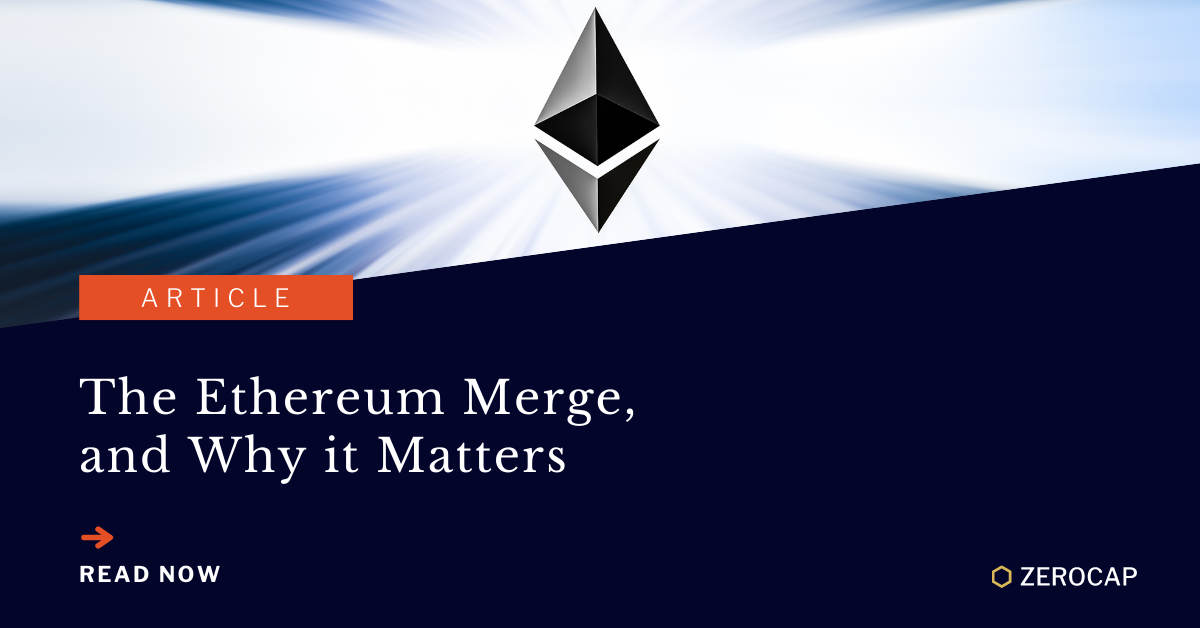Content
- Enter - The Modern Blockchain Trilemma
- But what does The Ethereum Merge mean for network participants?
- About Zerocap
- FAQs
- What is the Ethereum Merge and why is it significant?
- What are the environmental implications of the Ethereum Merge?
- How will the Ethereum Merge impact Ethereum's tokenomics?
- What changes will the Ethereum Merge bring to network participants?
- What are the potential investment opportunities arising from the Ethereum Merge?
22 Aug, 22
The Ethereum Merge, and Why it Matters

- Enter - The Modern Blockchain Trilemma
- But what does The Ethereum Merge mean for network participants?
- About Zerocap
- FAQs
- What is the Ethereum Merge and why is it significant?
- What are the environmental implications of the Ethereum Merge?
- How will the Ethereum Merge impact Ethereum's tokenomics?
- What changes will the Ethereum Merge bring to network participants?
- What are the potential investment opportunities arising from the Ethereum Merge?
“[Bitcoin’s] scripting language is too weak for any kind of serious advanced applications to be built on top.” – Vitalik Buterin
This famous quote from the co-founder of the Ethereum (ETH) network encapsulates the very essence of what ETH strives to be – a very different value proposition to Bitcoin (BTC), tasked with revolutionising the way people, businesses and institutions interact with and utilise the blockchain. Ethereum serves at the forefront of Web3 technology, offering composable smart contracts which provide the necessary foundation for decentralised applications, games and platforms to build upon.

Since Ethereum’s genesis block was mined on the 30th of July 2015, adoption of the cryptocurrency has exploded, seeing daily active addresses reach a recent all-time high of 1.07 million July 26, 2022. Users leverage the network to buy and sell digital assets, mint non-fungible tokens (NFTs), engage in Web3 gaming, manage supply chain logistics and securely store data. This expansion in network usage has unfortunately led to a plethora of scalability issues including increased network demand and congestion, larger storage requirements for node operators, surging electricity usage, higher gas fees and an associated spike in maximal extractable value (MEV) exploitation. Ethereum’s questionable long-term viability was unveiled recently by Yuga Labs, the founders of the Bored Ape Yacht Club, in their recent Otherside land deed sale. The sheer volume of transactions taking part in the Otherside land sale congested the network to a point at which it was virtually unusable. The mint burned over $157 million USD worth of Ethereum tokens ($ETH) in gas fees, forcing users to pay upwards of $10,000 USD in gas per successful & failed transaction. Solana, a competing layer one blockchain, has also fallen victim to the blockchain scaling epidemic, over catering to network throughput at the cost of network security and decentralisation. As a result, Solana’s mainnet has suffered numerous outages due to a series of software glitches, and distributed denial of service (DDoS) attacks.
Enter – The Modern Blockchain Trilemma
The blockchain trilemma, coined by Vitalik Buterin, is the popularised belief that decentralised networks, such as Ethereum, can only effectively offer two of the following three features: decentralisation, security and scalability at any given time. For the most part, this trilemma has held true, evident in the two cases above. Vitalik, along with the other founders of the Ethereum network has attempted to address this trilemma by laying the groundwork for various network upgrades and game-theory-influenced strategies. These upgrades are charged with improving network sustainability, scalability and throughput whilst simultaneously maintaining network security and decentralisation. These enhancements can be split into three core phases; layer 2 emergence, migration to proof-of-stake (PoS) and utilisation of sharding.
The arrival of layer 2 networks such as Arbitrum and StarkNet, have already driven improvements in Ethereum’s mainnet functionality. These Layer 2 networks utilise batched transactions in the form of Optimistic and Zero-Knowledge roll-ups, moving smart contract computation and storage off Ethereum’s mainnet; allowing for improvements in network throughput up to 100x. Despite their success, roll-ups suffer from their own unique drawbacks; Zero-Knowledge roll-ups with their lack of Ethereum Virtual Machine (EVM) compatibility, and Optimistic Rollups with their lengthy withdrawal times, owing to the extended fraud-proof challenge period (sometimes lasting longer than one week).
The Serenity phase was launched in response to existing scalability constraints and environmental concerns over the Ethereum network. Commencing in 2020, ETH’s Serenity Phase saw the establishment of the Beacon Chain and its underlying PoS consensus model amongst a host of other upgrades. Since then, the Beacon chain has been running in parallel with the existing mainnet, tasked with coordinating network stakers and portraying a ledger of accounts.
The upcoming September 15th-17th merge will see the current Beacon Chain merge with the Ethereum mainnet, becoming the main consensus and execution layer. This will force a mainnet transition from the current Proof-of-Work (PoW) consensus mechanism to PoS.
But what does The Ethereum Merge mean for network participants?
The implications of the Ethereum Merge are far-reaching with the transition to PoS bringing on a host of environmental, economic, and on-chain benefits. PoS will directly benefit the environment by cutting network electricity usage by over 99.9%, saving an estimated 112 terawatt-hours of electricity consumed by the Ethereum network annually. This will also indirectly boost $ETH’s competitiveness with another environmentally conscious layer one tokens such as Avalanche ($AVAX) and Algorand ($ALGO).
Moreover, with the difficulty bomb disincentivising mining by increasing the cryptographic difficulty level of mining puzzles, mining will become virtually impossible. Network participants will have to stake their $ETH tokens in order to validate blocks and earn yield, resulting in a significant reduction in $ETH’s circulating supply. This newfound scarcity should see token issuance shrink an estimated 90%. $ETH’s newfound deflationary tokenomics, in combination with increased investor demand (FOMO), will likely lead to significant upwards price pressure on $ETH in the short to medium term.
The emergence of validators will see a fundamental shift in both block building and proposal. Validators, being solely responsible for both block building and proposal, eliminates the need for expensive mining equipment and related knowledge when securing the network. This newly integrated PoS consensus mechanism will passively facilitate a greater degree of decentralisation, by removing costly informational and technological barriers to entry for network participants.
Unlike PoW, there is currently no in-built PoS mechanism enabling validators to capture MEV. Validators, instead, are incentivised to delegate the “mempool” search and block building to “Block Builders” in order to maximise their MEV. Mempool consists of a database of unconfirmed transactions in a blockchain network. Block Builders will be invaluable for the Ethereum network, lending their sophistication and expertise to validators, further optimising and decentralising the network. The ultimate goal of Block Builder amalgamation: is to foster “proposer/builder separation (PBS).”
Alongside $ETH’s new deflationary supply/demand dynamic, and a reduced environmental footprint, investors will relish an assortment of investment opportunities within the DeFi space. Liquid staking protocols, arguably one of the largest DeFi beneficiaries of the merge, should see their discounted liquid staked $ETH tokens (st$ETH) converge with the price of $ETH. As a clearer timeline for $ETH withdrawal emerges, Lido’s st$ETH/$ETH, which currently trades at 0.972 should begin to edge toward a 1:1 exchange rate. Another key opportunity for more savvy investors, resides in the potential for a PoW hard fork of the Ethereum network, and the associated PoW token drops. With a sustained uptick in lending rates on popular DeFi lending platforms such as AAVE or Compound, investors are able to lend their $ETH, taking advantage of staking arbitrageurs and short-term opportunists trying to capture token drops.
The upcoming merge presents a major stepping stone for the Ethereum network, expanding on existing foundations and building out new ones for what is to come. Vitalik himself claimed that post-merge the Ethereum network will still only be “55% complete,” with sharding, clear-cut PBS and an array of other upgrades yet to be revealed.
About Zerocap
Zerocap provides digital asset investment and custodial services to forward-thinking investors and institutions globally. Our investment team and Wealth Platform offer frictionless access to digital assets with industry-leading security. To learn more, contact the team at [email protected] or visit our website www.zerocap.com
FAQs
What is the Ethereum Merge and why is it significant?
The Ethereum Merge is a major network upgrade that will see the current Beacon Chain merge with the Ethereum mainnet, transitioning the network from a Proof-of-Work (PoW) consensus mechanism to Proof-of-Stake (PoS). This transition is significant as it aims to address the blockchain trilemma, improving network sustainability, scalability, and throughput while maintaining network security and decentralisation.
What are the environmental implications of the Ethereum Merge?
The Ethereum Merge is expected to significantly reduce the network’s environmental impact by cutting electricity usae by over 99.9%. This is due to the shift from energy-intensive PoW mining to more energy-efficient PoS staking. This reduction in energy consumption could make Ethereum more competitive with other environmentally conscious layer one tokens such as Avalanche ($AVAX) and Algorand ($ALGO).
How will the Ethereum Merge impact Ethereum’s tokenomics?
The Ethereum Merge is expected to introduce deflationary tokenomics to Ethereum. With the transition to PoS, network participants will need to stake their $ETH tokens to validate blocks and earn yield, reducing $ETH’s circulating supply. This reduction in token issuance, combined with increased investor demand, could lead to significant upward price pressure on $ETH in the short to medium term.
What changes will the Ethereum Merge bring to network participants?
The Ethereum Merge will bring about a fundamental shift in both block building and proposal. Validators, who will be solely responsible for both block building and proposal, will replace miners. This change will remove the need for expensive mining equipment and related knowledge, facilitating greater decentralisation by removing costly informational and technological barriers to entry for network participants.
What are the potential investment opportunities arising from the Ethereum Merge?
The Ethereum Merge presents several investment opportunities within the DeFi space. Liquid staking protocols could see their discounted liquid staked $ETH tokens converge with the price of $ETH. Additionally, there is potential for a PoW hard fork of the Ethereum network, and the associated PoW token drops could present opportunities for savvy investors.
Like this article? Share
Latest Insights
Ethereum Smart Contracts: How They Changed Crypto
Ethereum, launched in 2015, revolutionized the digital world by introducing “smart contracts,” self-executing contracts with the terms of the agreement directly written into code. This
Main Crypto Events in the World
The world of cryptocurrencies is dynamic and ever-evolving, with numerous conferences and events held globally to foster innovation, collaboration, and networking among crypto enthusiasts. Here’s
What is Ethena Finance?
Ethena Finance (ENA/USDe) is emerging as a notable player in the cryptocurrency and decentralized finance (DeFi) sectors. Powered by its proprietary stablecoin, USDe, Ethena aims
Receive Our Insights
Subscribe to receive our publications in newsletter format — the best way to stay informed about crypto asset market trends and topics.



 Share
Share  Tweet
Tweet  Post
Post 